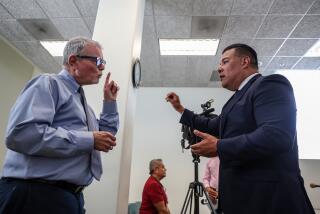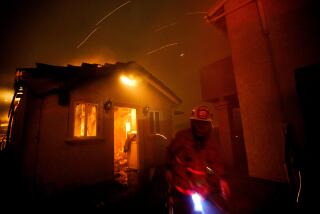London Underwriters’ Gamble Gets Tougher With Onset of War
- Share via
With hostilities under way, the continuation of commerce in the Mideast will depend on the calculations of London’s war-risk underwriters, the insurance agents who are almost always willing to write a policy on the ships, planes and cargo that ply the waters and airspace of combat zones--if the price is right.
The rates they set will determine where planes fly and ships cruise. The cost of insurance could have a strong bearing on how much oil is shipped from the Persian Gulf as tanker owners decide whether doing business there is economically feasible.
Insurance costs have risen substantially during the past week. But until more is known about the extent and intensity of the fighting, no one--including the underwriters at Lloyd’s of London--can predict how high rates will go.
“At the end of the day, they take a gamble,” says Peter Tritton, director of public relations for Alexander and Alexander Europe PLC, surveying the sober but hectic activity on one of Lloyd’s busy trading floors Tuesday, a day before the United States and its allies launched their attack on Iraq.
On Tuesday--as the United Nations deadline for Iraqi withdrawal from Kuwait was about to run out--Christopher Rome, a leading war-risk underwriter at Lloyd’s, wrote a policy for a tanker destined for Jubail, Saudi Arabia. He set a premium of 3% on the ship itself and 2% on the cargo.
By comparison, the standard cost of insuring cargo traveling between New York and London is 0.0275%--a hundred times less than the latest rates. On the other hand, premiums for ships sailing into the gulf during the Iran-Iraq War often reached 7.5% and sometimes exceeded 10%.
Although rate guidelines are sometimes issued, the London insurance industry acts as a free market, with individual underwriters deciding their own premium rates. Rome is one of about a dozen such experts in London, where 95% of the world’s war-related insurance is written. About 80% of all war-risk policies come through Lloyd’s.
Although other underwriters will take some of the risk on war-related policies, they wait for Rome and other war specialists to decide whether to insure a particular vessel, and then to set policy terms and quote a price.
Although selling high-premium war-risk insurance was once considered a nearly sure-fire way to amass a fortune, the Iran-Iraq War of the 1980s ended that notion. Lloyd’s underwriters paid out more than $1 billion in claims related to the conflict. Although some insurers profited, many others lost money.
“They’re still smarting from that,” Tritton says.
Before the first shot was fired in the current conflict, London underwriters faced $225 million in claims from the confiscation by the Iraqis of 15 Kuwait Airline jets.
In setting rates, war-risk underwriters consider where and when a ship is going and how long it will be there. “A very fast container ship is a good risk,” Rome says.
Against that set of variables, underwriters must weigh the latest political and military developments. For the majority of insurers who work through Lloyd’s, crucial information comes from a variety of sources. They include the far-flung network of Lloyd’s agents, established contacts around the world and the constantly updated postings on several big message boards on the Lloyd’s floor, each of which is marked “Intelligence.”
With fighting broken out, war-risk underwriters will analyze the damage inflicted on the Iraqi war machine, looking for clues that would indicate how dangerous the area remains for gulf shipping and aviation.
“The big question is whether Saddam (Hussein) can get through the net,” Tritton says. “With the volume of military ships there, chances seem slim.”
Industry analysts believe that oil tankers will not be specifically targeted--contrary to the situation during the Iran-Iraq conflict. But, as Rome points out, “An Exocet missile can’t tell one ship from another.”
There are other dangers as well, Rome noted. “We know there are a lot of mines floating in the gulf, he says. And “terrorism is a frightening risk this time.” Rome also notes that both the U.S. and British navies have advised all merchant shipping in the gulf not to sail north of the midline of the Persian Gulf.
“They must be telling us something,” he says.
In the bottom-line world of the underwriter, such advisories do not mean that Rome won’t insure ships traveling north of the line--only that they “should pay a lot more.”
Obtaining war-risk insurance is no different than obtaining other types. Ship and aircraft owners contact their brokers, who in turn seek out the appropriate underwriters and discuss terms and rates.
Inside Lloyd’s headquarters in London’s financial district, there are roughly 400 separate “syndicates” which act independently in underwriting policies. A broker is free to turn down a quote from one underwriter and move on to the next.
Almost no work is done over the telephone. All the men on the floor wear dark suits.
Brokers seeking war-risk insurance will go to one of the underwriters who specializes in war coverage. After a policy is agreed upon, the underwriter works out arrangements for other syndicates to assume part of the risk.
No war-risk coverage is available for anything on land--hotels, oil refineries, office buildings--because the possibility of massive claims is too great.
A nuclear blast would not mean the end of all war-risk underwriting, however.
Said the spokesman: “After the device has gone off, policies will be renegotiated.”
More to Read
Inside the business of entertainment
The Wide Shot brings you news, analysis and insights on everything from streaming wars to production — and what it all means for the future.
You may occasionally receive promotional content from the Los Angeles Times.










